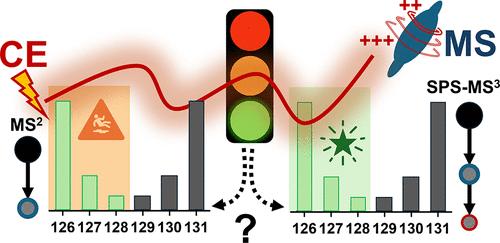毛细管电泳质谱蛋白质组学定量的多点验证:串联质量标签的等压复用
IF 6.7
1区 化学
Q1 CHEMISTRY, ANALYTICAL
引用次数: 0
摘要
采用等压条形码的多路复用定量技术在痕量敏感和单细胞质谱(MS)、纳米流液相色谱(nanoLC)和毛细管电泳(CE)中都得到了应用。在纳米olc -MS中,来自等压干扰的比例压缩已知会在串联质谱(MS2)中挑战定量准确性,这可以使用同步前体选择(SPS) MS3有效地补救。尽管CE-MS对自底向上的痕量敏感蛋白质组学越来越感兴趣,但使用该技术进行多重量化的保真度尚不清楚。在这里,我们通过使用经过验证的小鼠-酵母双蛋白质组模型全面调查定量深度,可重复性和准确性来解决这一基本知识差距。通过MS2和SPS-MS3策略进行基于ce的定量,以纳米olc SPS-MS3金标准为基准。我们发现电泳相关(Eco)离子分选将肽排序为名义上等压m/z值的高通量瞬态(Δm/z <;1 - 2)。当MS2方法与比例失真斗争时,SPS-MS3有力地消除了这两种分离的比例失真。结果表明,采用MS2或SPS-MS3定量法测定CE和nanoLC的重现性和准确性是不可区分的。CE使定量深度提高了约12倍。这些分析见解可用于设计具有高科学严谨性的痕量CE-MS研究。本文章由计算机程序翻译,如有差异,请以英文原文为准。

A Multipoint Validation of Quantification in Capillary Electrophoresis Mass Spectrometry Proteomics: Isobaric Multiplexing with Tandem Mass Tags
Multiplexing quantification using isobaric barcoding has gained traction in trace-sensitive and single-cell mass spectrometry (MS), both in nanoflow liquid chromatography (nanoLC) and capillary electrophoresis (CE). In nanoLC-MS, ratio compression from isobaric interferences is known to challenge quantification accuracy during tandem MS (MS2), which is effectively remedied using simultaneous precursor selection (SPS) MS3. Despite mounting interest in CE-MS for trace-sensitive bottom-up proteomics, the fidelity of multiplexed quantification is unknown using this technology. Here, we address this fundamental knowledge gap by holistically investigating quantification depth, reproducibility, and accuracy using a validated mouse–yeast two-proteome model. CE-based quantification via the MS2 and SPS-MS3 strategies were benchmarked against the nanoLC SPS-MS3 gold standard. We found electrophoresis-correlative (Eco) ion sorting to order peptides into high-flux transients of nominally isobaric m/z values (Δm/z < 1–2 Th). While the MS2 approach struggled with ratio distortion, the SPS-MS3 robustly eliminated them for both separations. The reproducibility and accuracy proved indistinguishable between CE and nanoLC using MS2 or SPS-MS3 quantification. CE enhanced the depth of quantification by ∼12-fold. These analytical insights can be used to design trace CE-MS studies with high scientific rigor.
求助全文
通过发布文献求助,成功后即可免费获取论文全文。
去求助
来源期刊

Analytical Chemistry
化学-分析化学
CiteScore
12.10
自引率
12.20%
发文量
1949
审稿时长
1.4 months
期刊介绍:
Analytical Chemistry, a peer-reviewed research journal, focuses on disseminating new and original knowledge across all branches of analytical chemistry. Fundamental articles may explore general principles of chemical measurement science and need not directly address existing or potential analytical methodology. They can be entirely theoretical or report experimental results. Contributions may cover various phases of analytical operations, including sampling, bioanalysis, electrochemistry, mass spectrometry, microscale and nanoscale systems, environmental analysis, separations, spectroscopy, chemical reactions and selectivity, instrumentation, imaging, surface analysis, and data processing. Papers discussing known analytical methods should present a significant, original application of the method, a notable improvement, or results on an important analyte.
 求助内容:
求助内容: 应助结果提醒方式:
应助结果提醒方式:


